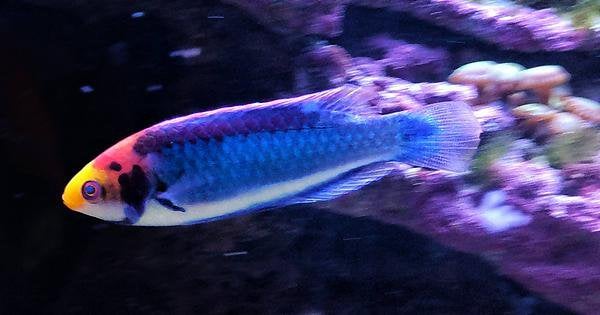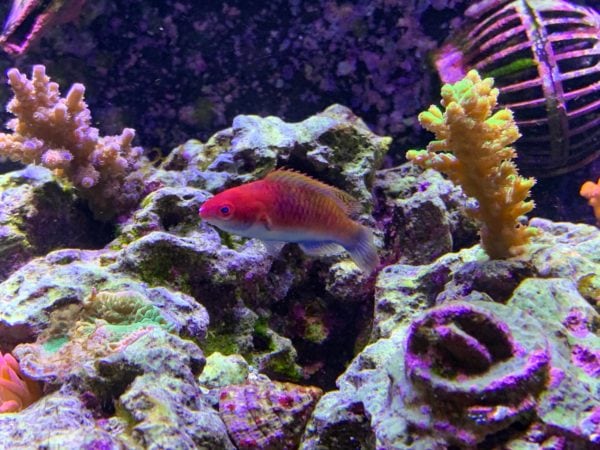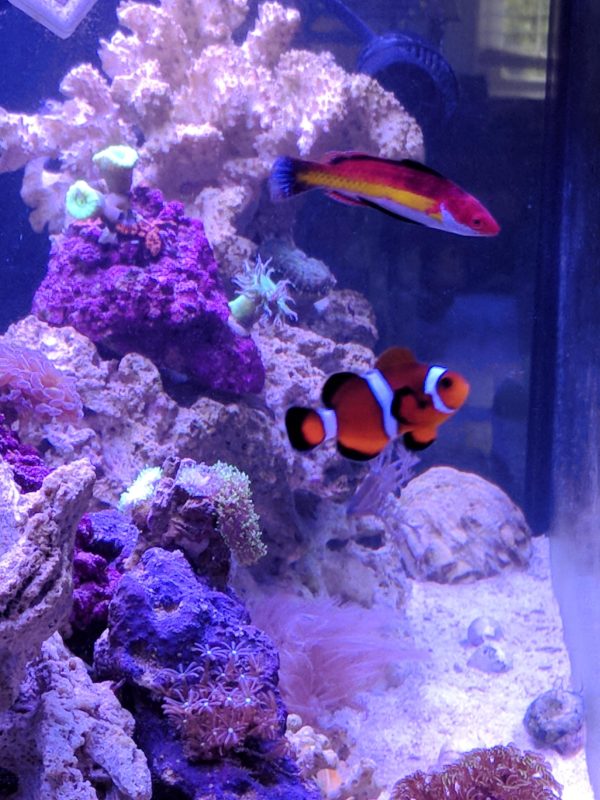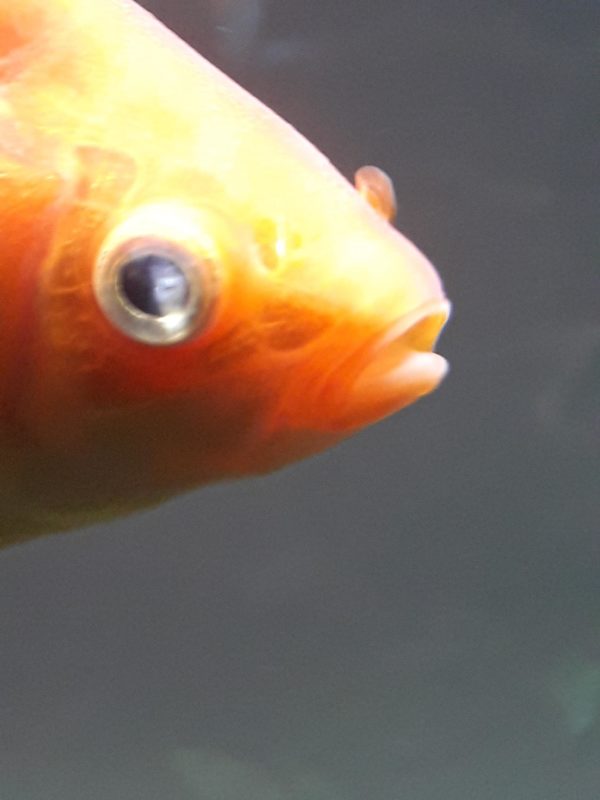Table of Contents
Fairy Wrasse Overview
The Fairy Wrasse is among the most beautiful marine water fish currently popular in the aquarium hobby. It exhibits vibrant colors with exciting striking patterns that make it look so stunning! In addition to their vibrant and exotic color, they also have a very active personality and a modest size that makes them so popular.
The fairy wrasse or the Cirrhilabrus genus is part of the Labridae family. They are native to the reefs of the Indian Ocean, the Red sea, and even in parts of the Pacific Ocean. There are about 60 species that have been identified as members of the Cirrhilabrus genus. The newest additions and discoveries have happened as recently as 2019. Needless to say, the Fairy Wrasse belongs to a very diverse species!
| Information Chart: | Fairy Wrasse |
| Scientific Name | Cirrhilabrus |
| Family | Labridae Family |
| Care Level | Easy to moderate |
| Temperament | Peaceful to semi-aggressive |
| Colour | A wide variety of colors depending on the type of Fairy Wrasse |
| Lifespan | Most species of Fairy Wrasse live for a period of 5 to 8 years. However, few wrasses have been known to live even for 30 years. |
| Size | Adults usually grow up to a size between 3 to 6 inches. |
| Diet | The preferred diet is carnivorous |
| Minimum Tank Size | Ranges from 50 to over 100 gallons depending on the species of Fairy Wrasse to be housed |
| Temperature | Between 72 and 78 degrees Fahrenheit (22 to 26 degrees Centigrade) |
| Water conditions | pH level should ideally be maintained between the range of 8.0 and 8.4 |
| Tank Mate Compatibility | Compatible with most peaceful fish that aren’t larger than them |
| Preferred Tank Set-Up | A combination of lots of open spaces for swimming with plenty of live rocks and caves for exploring |
| Sexual Dimorphism | Males are almost always larger and show more vibrant colors than females. |
| Lighting | Varies for each species of fairy wrasse. If they are deep divers, keep the lighting dim. |
Fairy Wrasse Appearance :

As we mentioned earlier, there are lots of different types of Fairy Wrasse that we can find, all with their colors and patterns. There are too many to describe the appearance of each one. If we did, this article would go on for significantly longer. Most fairy wrasses are dimorphic and dichromatic, meaning that they’re almost all born as females and then evolve into males. They are some of the most vividly colored fish that you can find in an aquarium. The colors are brighter when they are kept healthy. They are even more colorful when aggravated or during times of mating.
Fairy Wrasses typically swim with the help of their pectoral fins, just like other wrasses. However, these fish do have a couple of features that set them apart from the rest. If you observe their eyes, you can notice a double pupil, which is a consequence of their cornea being divided into two segments. The next feature is their teeth. Their teeth assist their carnivorous diet. There are three sets of canines, with two being on the upper jaw and the remaining set being on the lower jaw. Towards the rear, they have recurved teeth. This arrangement of teeth helps them catch, hold and mince the zooplankton that they typically feed on.
The different rainbow patterns on their body make them an extremely popular species of fish for aquarists to own and care for. There is also a huge variety of species you can adopt and add to your aquarium. Some of the popular choices are :
- Scott’s Wrasse (C. scottorum)
- Red – Headed Fairy Wrasse (C. solorensis)
- Orange – Back Fairy Wrasse (C. aurantidorsalis)
- Yellow – Flanked Fairy Wrasse (C. cyanopleura)
- Rhomboid Fairy Wrasse (C. rhomboidalis)
- Jordans Wrasse (C. jordani)
- Red – Margined Fairy Wrasse (C. rubrimarginatus)
- Yellow – Streaked Fairy Wrasse (C. luteovittatus)
- Red Velvet Fairy Wrasse (C. rubrisquamis)
- Lubbock’s Fairy Wrasse (C. lubbocki)
- Yellow fin fairy wrasse (C. flavidorsalis)
- Lined fairy wrasse (C. lineatus)
- Long-finned fairy wrasse (C. rubriventralis)
The lifespan of Fairy Wrasse :
The typical lifespan of a Fairy Wrasse is between 5 to 8 years.
However, this is not for all species of Fairy Wrasse. The actual lifespan is subject to variation based on the species. There have been reports of certain Wrasse living for up to even 30 years. Also, all these observations are subject to them being in ideal and hospitable conditions.
Fairy Wrasse Size :
The typical Fairy Wrasse grows to a size of about 6 inches on the lower end and 6 inches for a larger specimen.
However, this is not a standard. The size of different specimens may vary. This is just an average size indicator for Fairy Wrasse, subject to the assumption that they are exposed to ideal conditions throughout their life. In the wild, they are preyed upon by other fish and this also significantly affects their lifespan.
Natural Habitat and Origin :
The Fairy Wrasse is a marine water fish that is originally known to occupy coastal reef habitats where there is coral rubble substrate. This fish is known to hang over small coral mounds or soft corals where they can easily hide when they detect danger. There are still some species of fish that are found even in clean oceanic reefs where they can be found on the hunt for small foods, including invertebrates.
Fairy Wrasses are endemic to the Red Sea through the Indian Ocean and across the Pacific Ocean to the Pitcairn Islands, all the way to Hawaii and Japan. In their natural habitat, they are usually found in small groups feeding on zooplankton just above the substrate. This is also subject to which specific species of fairy wrasse we focus on. Some of them can be found a few feet beneath the surface, while other deep-diving species can be found as low as 600 feet below the surface.
Fairy Wrasse Care and Tank Set-Up :
Fairy Wrasse Tank Size and Specifications :
Optimum Tank Size for Fairy Wrasse :

The recommended tank size for Fairy Wrasse is 48 inches long, 13 inches wide, and 21 inches tall.
These are the dimensions for a tank that is 55 gallons in volume. However, for other species of fairy wrasse, the volume could also vary and go beyond even 100 gallons. 55 gallons is the absolute minimum tank size that should be kept for Fairy Wrasse.
Filter Type :
Fairy Wrasses are fish that require large tanks. This means there is also a lot of water that needs to be cleaned regularly – saltwater, to be specific. Filtration is key in any aquarium, but more so in saltwater aquariums. Your best bet would be to go with a canister filter, as it is far more powerful than an internal filter or a hang on the back filter system. Just make sure that the model you pick is compatible with the flow rate for your tank. A thumb rule is to make sure your aquarium can clean four times the volume of water in your aquarium.
Substrate :
When it comes to fairy wrasse or rather any fish from the Labridae family, the substrate is not too big of an issue, meaning it usually comes down to personal preference. A sandy substrate is a viable option. This is mainly because the natural habitat has lots of corals with sandy substrates.
How many Fairy Wrasse in a 275 Gallon Tank?
You shouldn’t be keeping more than 5 or 6 fairy wrasse in a tank of that size. They tend to become territorial at times, so they need ample space.
Water Parameters for Fairy Wrasse :
Water Temperature:
The ideal water temperature for Fairy Wrasse would be between 72 and 78 degrees Fahrenheit (22 to 26 degrees Centigrade).
Fairy Wrasses are found in coral reefs. The water temperature here is usually a little warm, and so if you’re living in cold areas, you may need a water heater for your Fairy Wrasse.
pH Level :
The perfect water pH level for Fairy Wrasse is ideally a value that lies between the range of 8.0 and 8.4
If the pH value is not maintained, it adversely affects the fish and could potentially also shorten the lifespan of the fish.
Water Hardness :
The recommended water hardness for a tank that is to house Fairy Wrasse is a value that lies between 8 to 12 dKH.
Fairy Wrasse Tank Landscape :
Most Fairy Wrasses and, by extension, fish from the Labridae family are not the kind that requires a lot of items to complete their tank set – up. Replicating their natural habitat is the goal. This can be achieved by populating the tank with multiple live rocks, and a sandy substrate is a good start. You can add to this by adding some live plants as well. The only issue you might come across is regarding space, as they do require large tanks.

Best Plants for Fairy Wrasse Tanks :
The tank for fairy wrasse is a reef tank. This means it is a saltwater aquarium and not a freshwater aquarium. The plants in a freshwater aquarium are different from the ones that can be kept in a reef tank. Some of the plants that are great in a saltwater aquarium are listed here :
- Red Gracilaria Algae
- Mermaid’s Fan (Halimeda Udotea)
- Sea Lettuce (Ulva Lactuca)
- Tufted Joint Algae (Cymopolia Barbata)
- Halimeda
- Green Finger Plant (Codium Spongiosum)
- Red Mangrove Propagule (Rhizophora Mangle)
- Spaghetti Algae (Chaetomorpha Linum)
- Dragon’s Tongue Algae (Halymenia Dilatata)
Worst Plants for Fairy Wrasse :
Plants that are not a good addition to the tank for fairy wrasse would be plants that are not suited to saltwater. This is because freshwater plants will not thrive in saltwater. They will lose their luster and will soon die.
Decorations for Fairy Wrasse Tanks :
When it comes to setting up a reef tank for fairy wrasse, make sure to add a lot of live plants and rocks that serve as hiding spots. This will make the wrasse feel at ease and keep them relaxed and stress-free. The fact that the tank is populated heavily with rocks and caves makes the fish feel like they are at home as it replicates the reefs in the ocean.
Lighting for Fairy Wrasse Tanks :
The lighting of the tanks depends on the type of fairy wrasse that is being kept. If it is a deep-diving wrasse, then the lights should be kept dim and must be of very low intensity. Fish that go deep into the water are exposed to comparatively less light. If they are exposed to light at a higher intensity, then this will tend to harm them. However, lighting is a critical factor that affects the growth of the plants and the corals in the tank. It also ensures that a regular cycle of night and day is followed. Make sure you know if your fairy wrasse is a deep diver or not. Based on this, you can pick the sort of lighting you need for your tank.
Feeding Fairy Wrasse :
Best Diet for Fairy Wrasse :
The fairy wrasse is carnivorous and is an active hunter who will not sit back and wait to be fed but rather walk around looking for food. One amazing fact with the fish is that it is very easy to feed and will readily eat even fish food pellets that it is offered. When the fish is still new in the tank, it is highly recommended that they be fed brine that is enriched. When the fish slowly start to get used to living in captivity, you can introduce Mysis shrimp or zooplankton to them. This is a food source that and they will happily feed on.
Just like other carnivorous fish, the fairy wrasse should ideally be given multiple feedings a day in small amounts. As we mentioned earlier, they are not a species that will wait to be fed. They are hunters and will hunt for food if they get hungry. In their natural habitat, they prey on plankton in open water and invertebrates that live on the substrate like flatworms. Apart from living food, they also accept being fed flakes and pellets. A balanced diet consisting of large amounts of live food and a bit of flake food will go a long way in maintaining their health.
How often should you feed Fairy Wrasse?
Fairy Wrasse should typically be fed four to six times every day. Fairy Wrasses are carnivorous fish and need to be fed frequently in small quantities. They are usually given pellets or flakes about thrice a day and are fed live food about twice a day.
Fairy Wrasse Behaviour and Temperament :
Are Fairy Wrasses lone or Societal in nature?
Fairy Wrasses are typically happy fish that don’t necessarily need to stay in schools. Some of them prefer being alone and do better when kept by themselves. However, be careful before adding more than one male of the same species, as they do tend to get territorial. Fairy Wrasses are best kept together in a harem arrangement with multiple females and just a single male to avoid any aggression between them. Also, be careful before introducing new tankmates as they might be startled by their presence and could charge at them. Also, make sure that the lid on the tank is perfectly secured as tense situations like these may lead to the wrasse possibly jumping out of the water.
Fairy Wrasse Tank Mates :
Ideal Tank Mates for Fairy Wrasse :

As compared to other Fairy Wrasse, these fish get along well with a lot of other species that are not their own. One of the major factors to consider would be to make sure that the species is not a carnivore like fairy wrasses. Also, you will have to find out which fish you should add to the aquarium first and which one to add after. This, too, influences the behavior of the fish towards each other. Certain fish species like Frogspawn Corals, damsels, gobies, blennies, pygmy angels, and cardinals can be kept along with Fairy Wrasse.
Bad Tank Mates for Fairy Wrasse :
It is best to avoid fish that sports a similar color or pattern like the fairy wrasse. You must also note that two males of the same species of fairy wrasse shouldn’t be kept together as they can get very territorial and aggressive. Another group of fish that must be steered clear of is large predatory fish. Examples of this may include groupers, lionfish, puffers, other species of wrasse that are bigger, and many species of triggerfish.
Breeding Fairy Wrasse :
The first thing that must be known before we talk about breeding fairy wrasse is the fact that they are all hermaphrodites. It is a peculiar fish when it comes to breeding as there have been no juvenile males found even in the wild! It is the female fish that is dominant that will change into a male in a group of the fish. Else, it is usually an external factor that causes females to change gender. Usually, something like the death or the capture of the most dominant male in the tank will cause this phenomenon.
To encourage the breeding of these fish, it is best to have just a single male with many females in a harem. The behavior of fairy wrasse during their spawning phase is quite a sight to see. There is a flurry of activity that is coupled with their vivid color. This is a show that must not be missed. Putting many males in a single harem usually leads to fights between the males. These types of fights are usually not beneficial to the whole fish harem. Not much has been documented about aquarium breeding of this fish; perhaps this is something that is best left to the experts.
Fairy Wrasse Breeding Level – Hard
Fairy Wrasse Sexual Dimorphism :
To distinguish between fairy wrasse, we first look at the size and color of the fish. The Males are generally larger and display more vibrant color on their bodies as compared to the females. Another important fact that must be noted is the fact that fairy wrasses are hermaphrodites. They can also change gender both ways multiple times over their lifespan.
Fairy Wrasse Common Diseases and their Treatment :
Fin Rot :
One of the most common diseases that affect fish of all habitats (saltwater, freshwater, and cold water) is fin rot. Fin rot is generally an easily spotted condition where the fins and tail of a fish become noticeably degraded. They may change colors, appear inflamed at the base, and be frayed or ragged. Fin degradation begins at the edges of the fin and works its way toward the base. Once the infection reaches the base, the fish will not be able to regenerate new fin tissue, and the infection may spread to the body. Fin rot may be a symptom of disease, but this is not always the case.
Pop – Eye :

Pop-eye is a common symptom that could be a result of any number of infections. This is another noticeable symptom. Pop-eye occurs when fluid builds up either behind the eye or in the eye. This causes bubbles in the skin surrounding the eye, eventually causing the eye to bulge out of its socket. If not treated in time, the fish can lose sight in the affected eye.
White Spot (Ich) :
Ich is caused by an external parasite that causes multiple white spots on your freshwater fishes’ skin and gills. The most common cause of Ich is failure to quarantine a new fish added to the aquarium. To treat your infected fish, a veterinarian will need to take a look first. They will prescribe a treatment for the fish. Meanwhile, maintaining your water conditions is key to eliminating Ich from your tank.
Facts about Fairy Wrasse :
- There are over 500 species of Wrasse
- When we talk about Fairy Wrasses, in particular, there are about 60 different species that have been discovered so far.
- Fairy Wrasse are hermaphrodites, meaning they can change their gender
- These fish are some of the most colorful fish that you can see in an aquarium
- Fairy Wrasse are typically most active during the day, making them diurnal
- The telltale sign of a fairy wrasse is large lips and a pointed snout, accompanied by menacing teeth to support its carnivorous diet
Are Fairy Wrasses Right for You?
Fairy Wrasses are some of the most colorful fish that can be added to your saltwater aquarium. However, they are not exactly beginner-friendly fish. They can also be aggressive at times, and their diet is also quite demanding. They are also not the cheapest fish to own and maintain. Another factor to consider is the amount of space they require and their compatibility with other fish. They require large amounts of space, meaning a large tank. Think it all over before you go ahead and decide to populate your tank with fairy wrasse.
FAQ :
Are Wrasses good for beginners?
Wrasses are not recommended to beginners, but certain species might be suited to beginner aquarists. This is largely due to the costs and meticulous efforts involved in the maintenance of the fish and their habitat.
Are Wrasses good pets?
Sure, wrasses can be great pets, provided they are well cared for. They are also relatively active fish, and seeing their brightly colored bodies swim around your aquarium is always a delight.
Are Wrasses difficult to take care of?
Again, the difficulty of caring when it comes to wrasses is subject to the species of fish you are interested in. Some of them are quite easy to take care of and maintain, while other species can be quite challenging.
Can you raise Wrasse in captivity?
As we talked about extensively in our breeding section, breeding fairy wrasse is an incredibly tricky task. Not much is known about breeding them in aquariums at home, and there are only two cases where they have successfully been bred in captivity.
Conclusion :
Fairy Wrasse can be a stunning addition to your tank, provided they are very well cared for. If you are a beginner, we suggest you hold off on adopting them until you gain some more experience. If you manage to find that sweet spot with these fish and manage to balance out their aggression and meet their care requirements, you will be rewarded with these gems in your tank. They are a wonderful addition to any saltwater aquarium and will be an eye-catcher. We wish you the best of luck in your journey to care for and keep Fairy Wrasse!
No related posts.
